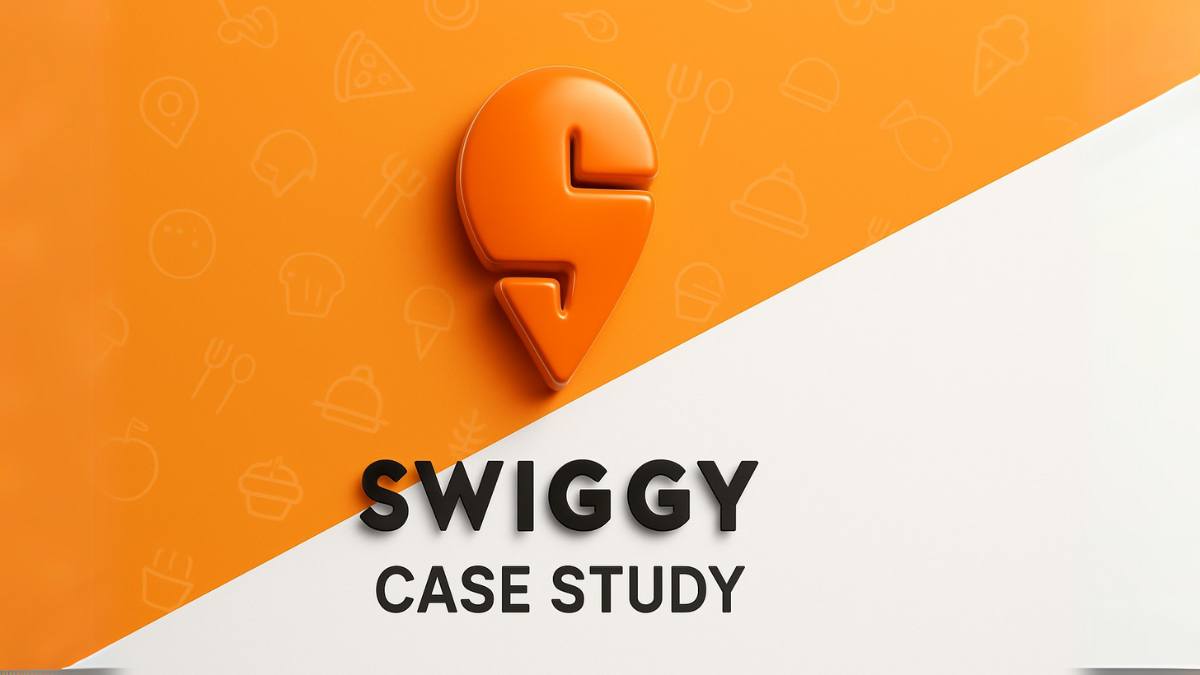Imagine you’re hungry, it’s raining outside, and cooking just feels like a task.
You open an app, place an order, and within minutes, hot food arrives at your doorstep. That experience? It’s powered by companies like Swiggy.
This Swiggy case study takes you behind the scenes of how a startup changed the way India eats.
Swiggy didn’t just enter the food delivery space, it reshaped it. In a market that already had players like Zomato, Swiggy carved its own path.
So why should marketers, creators, or entrepreneurs care? Because Swiggy is more than a food app. It’s a masterclass in solving real problems with smart tech, brilliant marketing, and customer obsession. Let’s break it all down.
Table of Contents
Meet the Founders of Swiggy
Swiggy was founded in 2014 by three friends:
- Sriharsha Majety
- Nandan Reddy
- Rahul Jaimini (ex-Flipkart engineer)
Before Swiggy, Harsha and Nandan had started a logistics company called Bundl. It didn’t quite work out, but it gave them key insights into how deliveries work in India.
The food tech idea came later. The founders noticed that restaurants struggled with reliable delivery. Many used random delivery boys with no real tracking or service consistency.
That’s when the team decided:
“Let’s do the delivery ourselves.”
This shift, from just connecting customers to restaurants, to managing the entire experience, became Swiggy’s magic formula.
The Origin Story: How Swiggy Was Born
The early days were tough. Really tough.
Swiggy didn’t launch nationwide right away. They began with just a few restaurants in Bengaluru. No flashy ads. Just a basic app and a few delivery boys.
But what made them different?
- They hired their own delivery staff.
- They promised reliability: What you see is what you get.
- They focused on timely delivery, not just fancy UI.
Competitors at the time were mostly marketplaces, connecting customers to restaurants, but not handling delivery.
Swiggy’s full-stack model gave them control, and customers loved it.
Also Read: Myntra Case Study
Swiggy’s Business Model Explained
Swiggy follows a multi-revenue model that gives it flexibility and long-term growth potential. Here’s how they make money:
1. Commissions from Partner Restaurants
Swiggy charges restaurants a commission for every order placed through the app, usually between 17% to 25%. The better the visibility a restaurant wants, the higher the commission. This is a core source of revenue. (Source)
2. Delivery Charges from Customers
Depending on distance, traffic, and time (like late-night orders), Swiggy adds a delivery fee. These small charges add up and help Swiggy manage costs, especially in areas with lower order volume.
3. Swiggy One (Subscription Plan)
This is Swiggy’s paid membership program. It gives users free deliveries, exclusive deals, and priority support. For Swiggy, it provides recurring revenue and higher customer retention.
4. Advertising & Sponsored Listings
Restaurants pay to appear higher in search results or get featured banners. This ad revenue works like Google Ads but inside the app, offering better visibility in exchange for money.
5. Instamart, Dineout, and Other Verticals
Swiggy is expanding beyond food. Instamart delivers groceries in minutes, while Dineout offers table reservations and dining deals. These verticals help Swiggy diversify and earn more across different categories.
Also Read: Uniqlo Case Study
Swiggy’s Growth Engine: What Set It Apart
Let’s talk about why Swiggy grew so fast, while many startups struggled.
1. Tech + Logistics Advantage
Swiggy built strong tech to handle orders, delivery routing, and tracking. Every delivery boy had the app. Customers could track every move.
2. Full-Stack Control
Unlike platforms that just showed listings, Swiggy owned the delivery layer. This control gave better service, faster orders, and fewer failures.
3. Hyperlocal Focus
Each city, each zone was treated differently. Swiggy didn’t try to scale blindly. They focused block by block, creating strong local networks. That attention to detail made a huge difference.
Also Read: Advanced Digital Marketing Course in Panchkula
Marketing Strategies of Swiggy That Fueled Its Growth
Swiggy’s marketing? Fun, bold, and deeply local. Here’s how they did it:
1. Guerrilla Marketing in the Early Days
Before they had big money, Swiggy used simple, clever tactics, like flyers in apartments, free deliveries, and referral discounts.
2. IPL & Meme Marketing
They sponsored cricket events, used meme culture, and created city-specific ads that spoke the local language.
3. Performance Marketing & Influencers
Swiggy ran powerful Google & Facebook ad campaigns. They also teamed up with food bloggers and influencers to create buzz.
4. Personalized Offers
Using data, Swiggy sent offers based on your past orders, time of day, or even your mood (based on weather!).

Enroll Now: Advanced Digital Marketing Course
How Swiggy Retains Customers
Swiggy puts in a lot of effort to keep users coming back, not just ordering once and forgetting. Here’s how they do it:
1. Swiggy One Subscription
This loyalty program gives benefits like unlimited free deliveries, no surge pricing, and early access to deals. It encourages people to stick with Swiggy instead of switching to another app.
2. Gamified Rewards & Campaigns
Swiggy often runs interactive promotions where users win rewards by ordering more or reaching milestones. These playful campaigns add fun and make people feel valued beyond the order itself.
3. Clean UX and Fast App Experience
The app is simple, smooth, and quick. Features like saved addresses, one-tap reorders, and real-time order tracking create a hassle-free experience, which builds habit and trust.
4. Smart Notifications & Personalized Offers
Based on your ordering habits, location, and time, Swiggy sends tailored notifications and deals. This personalization makes the app feel more relevant, which increases repeat usage.
5. Trust Through Consistency
Timely refunds, order accuracy, and visible support build user confidence. People are more likely to return to a platform that feels fair, fast, and reliable.
Also Read: Netflix Case Study
How Swiggy Understands & Leverages Consumer Behavior
Swiggy is not just about delivering food. It’s about understanding what users want, before they even ask for it.
1. Personalization with Data
Swiggy uses your order history, location, and even the time of day to suggest the perfect meal.
Example: If you order biryani every Friday, the app will likely recommend it again around that time.
2. Optimizing Delivery Based on Behavior
They track how often a user cancels, how long they wait, or what restaurants get the most repeat orders.
This helps Swiggy improve routes, timings, and menu listings.
3. Feedback Loops
After every order, Swiggy asks for ratings. If a restaurant keeps getting low scores, Swiggy can reduce its visibility, or even stop showing it.
It’s a constant loop of listening and improving.
Also Read: Starbucks Case Study
Key Challenges & How Swiggy Tackled Them
No journey is perfect. Swiggy had to deal with major bumps along the road. Here’s how they handled them:
1. Burn Rate & Funding Winters
Swiggy was spending more than it earned in early years. During tough funding times, they cut back on expansion and focused on being efficient.
They also improved margins with Instamart and Swiggy One.
2. Zomato Competition
Zomato is a strong rival. But Swiggy focused on faster delivery, better UI, and local campaigns to win hearts. Read more about Zomato in our detailed Zomato Case Study.
They didn’t try to copy, just improved what they were already good at.
3. Workforce & Strike Issues
Delivery boys are the backbone. There were times when they went on strike over pay.
Swiggy responded by adjusting incentives, offering support, and opening better communication channels.
4. COVID-19 Disruption
Food delivery slowed down during lockdowns. So, Swiggy pivoted fast and focused on Instamart (grocery delivery).
That move helped them stay alive when restaurants were shut.
Also Read: Coca-Cola Case Study
Lessons for Digital Marketers & Founders
Here are some easy-to-remember but powerful lessons from Swiggy’s journey:
1. Start Small, Scale Smart
Swiggy began with just a few restaurants in one city. They focused on solving delivery challenges well before expanding. The lesson? Nail your service in one market before chasing growth.
2. Own the Full Experience
Instead of relying on third parties, Swiggy managed its own delivery team. Controlling the user experience helped them ensure speed, consistency, and better service.
3. Know Your Customer Deeply
Swiggy’s success came from data. They knew when you were likely to order, what you’d want, and how to make that process smooth. Insight beats guesswork, every time.
Also Read: McDonald’s Case Study
4. Be Creative with Marketing
From quirky social media posts to IPL tie-ins, Swiggy always kept its marketing fresh and local. Your brand voice should feel human, fun, and in tune with your audience.
5. Pivot When Needed
When COVID hit, food orders slowed, but Swiggy quickly shifted focus to grocery delivery with Instamart. Flexibility in strategy is key for survival.
6. Build for Retention, Not Just Acquisition
Getting users is one thing; keeping them is harder. Swiggy invests in loyalty programs, clean design, and fast support, so users keep coming back.
Also Read: Amazon Case Study
Conclusion
Swiggy’s journey shows how a small startup can become a household name, not just by offering a service, but by owning the full experience.
As they explore more areas like Instamart, dine-in offers, and maybe even drone delivery in the future, one thing is clear: Swiggy isn’t done growing.
For marketers and founders, Swiggy is a powerful example of how to combine tech, trust, and timing.
They didn’t wait for perfect conditions, they created them. And that’s the biggest lesson of all.
FAQs: Swiggy Case Study
1. Who is the founder of Swiggy and when was it launched?
Swiggy was founded in 2014 by Sriharsha Majety, Nandan Reddy, and Rahul Jaimini. They started in Bengaluru with just a few restaurants and delivery partners.
2. What is Swiggy’s main source of revenue?
Swiggy mainly earns money through restaurant commissions, delivery charges from customers, and paid promotions inside the app.
3. How does Swiggy stand out from Zomato?
Swiggy controls its own delivery system, which helps in faster, more reliable service. Zomato mostly started as a listing platform and added delivery later.
4. What marketing strategies make Swiggy successful?
Swiggy uses city-based ads, meme marketing, influencer tie-ups, and smart performance ads. Their campaigns are always fun, relevant, and highly targeted.
5. How does Swiggy retain customers in a competitive market?
With features like Swiggy One, real-time tracking, fast refunds, gamified rewards, and strong UX, Swiggy keeps users coming back.
6. What can startups learn from Swiggy’s business model?
Startups can learn to focus on full control, customer trust, strong backend tech, and staying flexible when things go wrong.

